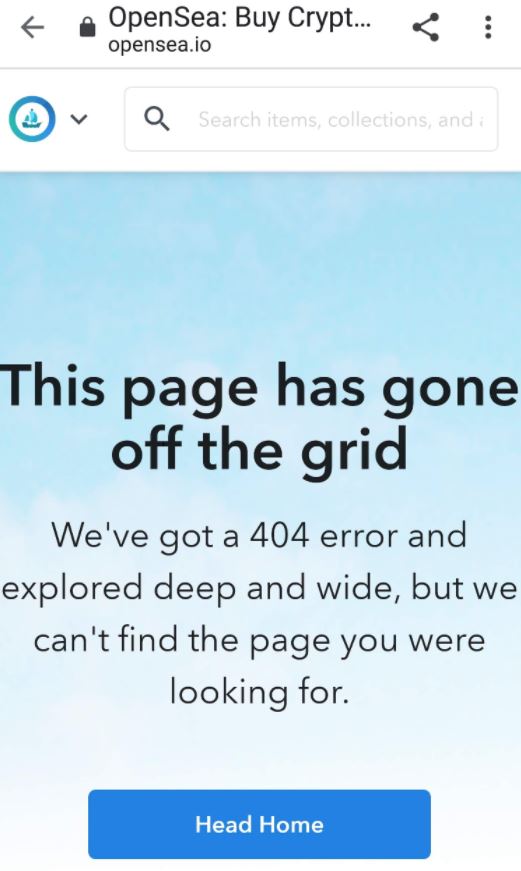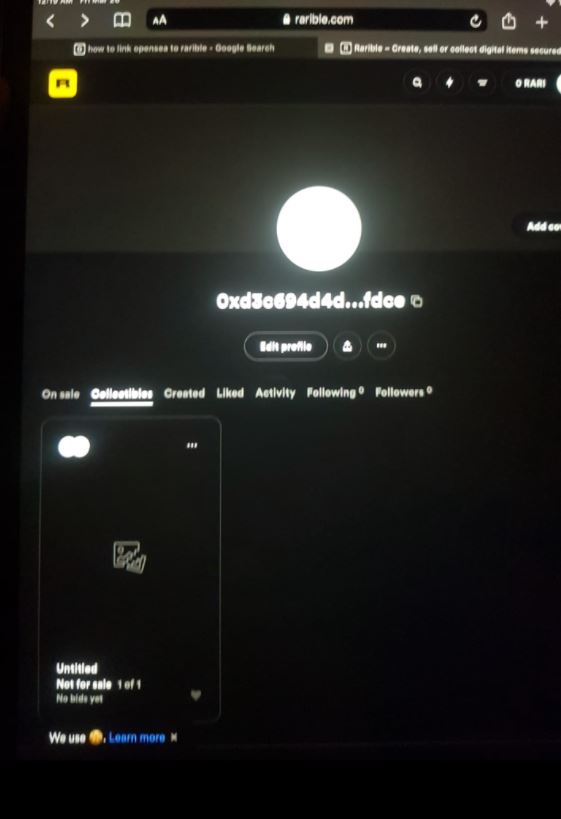Last month, Tom Kuennen, a property manager from Ontario, coughed up $500 worth of cryptocurrency for a JPEG of an Elon Musk-themed “Moon Ticket” from DarpaLabs, an anonymous digital art collective. He purchased it through the marketplace OpenSea, one of the largest vendors of so-called non-fungible tokens, or NFTs, in the hopes of reselling it for a profit.
“It’s like a casino,” he said in an interview. “If it goes up 100 times you resell it, if it doesn't, well, you don’t tell anyone.”
He never got the chance to find out. A week later, he opened up his digital “wallet,” where the artwork would supposedly be available, and was faced with an ominous banner reading, “This page has gone off grid. We’ve got a 404 error and explored deep and wide, but we can’t find the page you’re looking for.”
The artwork, which he expected to be on the page, had disappeared entirely. “There was no history of my ever purchasing it, or ever owning it,” he said. “Now there’s nothing. My money’s gone.”

Was it a glitch? A hack? Did Kuennen perhaps misunderstand how, exactly, NFTs work and how they’re stored? You can’t blame him; over the past few months, numerous individuals have complained about their NFTs going “missing,” “disappearing,” or becoming otherwise unavailable on social media. This despite the oft-repeated NFT sales pitch: that NFT artworks are logged immutably, and irreversibly, onto the Ethereum blockchain.
So why would an NFT go missing? The answer, it turns out, points to the complex working of NFTs that are often misunderstood even by the people willing to shell out large sums for them.
How to make an NFT disappear
When you buy an NFT for potentially as much as an actual house, in most cases you're not purchasing an artwork or even an image file. Instead, you are buying a little bit of code that references a piece of media located somewhere else on the internet. This is where the problems begin.
Ed Clements is a community manager for OpenSea who fields these kinds of problems daily. In an interview, he explained that digital artworks themselves are not immutably registered “on the blockchain” when a purchase is made. When you buy an artwork, rather, you’re “minting” a new cryptographic signature that, when decoded, points to an image hosted elsewhere. This could be a regular website, or it might be the InterPlanetary File System, a large peer-to-peer file storage system.
Clements distinguished between the NFT artwork (the image) and the NFT, which is the little cryptographic signature that actually gets logged.
"I use the analogy of OpenSea and similar platforms acting like windows into a gallery where your NFT is hanging,” he said. “The platform can close the window whenever they want, but the NFT still exists and it is up to each platform to decide whether or not they want to close their window.”
So when Kuennen bought that Moon Ticket, there was no JPEG logged onto the blockchain itself. There was just a certificate, pointing to an URL. And that pointer, Clements explained, can be suppressed for a number of reasons, including a violation of a marketplace’s terms and conditions. Copyright violations and stolen artworks are a feature of the emerging NFT space.
"Closing the window" on an NFT isn't difficult. NFTs are rendered visually only on the front-end of a given marketplace, where you see all the images on offer. All the front-end code does is sift through the alphanumeric soup on the blockchain to produce a URL that links to where the image is hosted, or less commonly metadata which describes the image. According to Clement: “the code that finds the information on the blockchain and displays the images and information is simply told, ‘don't display this one.’”
“NFTs come in all different shapes and sizes,” added Mewny, a pseudonymous developer at eGirl Capital, which provides data insights into the cryptocurrency world. “Usually OpenSea will either have to render the image from on-chain metadata or retrieve it from a link in the metadata.”
But “in both cases,” he said, “it can simply choose not to.”
An important point to reiterate is that while NFT artworks can be taken down, the NFTs themselves live inside Ethereum. This means that the NFT marketplaces can only interact with and interpret that data, but cannot edit or remove it. As long as the linked image hasn't been removed from its source, an NFT bought on OpenSea could still be viewed on Rarible, SuperRare, or whatever—they are all just interfaces to the ledger.
The kind of suppression detailed by Clements is likely the explanation for many cases of "missing" NFTs, such as one case documented on Reddit when user "elm099" complained that an NFT called “Big Boy Pants” had disappeared from his wallet. In this case, the user could see the NFT transaction logged on the blockchain, but couldn’t find the image itself.
In the case that an NFT artwork was actually removed at the source, rather than suppressed by a marketplace, then it would not display no matter which website you used. If you saved the image to your phone before it was removed, you could gaze at it while absorbing the aura of a cryptographic signature displayed on a second screen, but that could lessen the already-tenuous connection between NFT and artwork.
Missing from the blockchain
For Kuennen, though, this explanation was wholly unsatisfactory. He was doubtful that his NFT violated OpenSea’s terms and conditions, and he received no correspondence to that effect. No email, no warning, nothing.
He said he couldn’t even find a record of the token itself on the Ethereum blockchain, though he was able to view the transaction in which he spent $500 and bought the image. This was truly disturbing, because even if an NFT artwork has been taken down, the signature should still be available.
We called up a few developers, and they were just as baffled as Kuennen.
“This one’s a pickle,” said Mewny, speculating that the token hadn’t actually been minted at all, and that it would be minted “properly” at a later date in order to save on expensive Ethereum fees. It’s not unlike those cafeterias which sell customers little plastic tokens that can later be exchanged for food after queuing. Except in this case, the token is invisible, the queue never ends, and the “food” is a JPEG stuck to a wall—which abruptly disappears after about a week.
Sam Williams, the founder of Arweave, an Ethereum file storage application, pointed to a recent OpenSea update in which the company began to mint tokens only after a sale is made to minimise losses from gas fees in the case of a botched sale.
As it turns out, however, the resolution to the riddle of Kuennen’s missing NFT record on the blockchain has to do with even more arcane Ethereum minutiae. Strap in.
NFTs are generally represented by a form of token called the ERC-721. It’s just as simple to locate this token’s whereabouts as ether (Ethereum's in-house currency) and other tokens such as ERC-20s. The NFT marketplace SuperRare, for instance, sends tokens directly to buyers’ wallets, where their movements can be tracked rather easily. The token can then generally be found under the ERC-721 tab.
OpenSea, however, has been experimenting with a new new token variant: the ERC-1155, a “multitoken” that designates collections of NFTs.
This token standard, novel as it is, isn’t yet compatible with Etherscan, said Williams. That means ERC-1155s saved on Ethereum don’t show up, even if we know they are on the blockchain because the payments record is there, and the “smart contracts” which process the sale are designed to fail instantly if the exchange can’t be made.
Take, for instance, the buyer B39A88, who last week purchased this collection by the artist “Foswell Banks.” (Who may or may not be this reporter.) The payment record is there and the art is on OpenSea. But under the ERC-721 tab the NFT tied to the artwork is nowhere to be seen. We know, however, that it is online; it’s just not compatible with Etherscan.
Mystery solved
In the end, it turns out that the case of Kuennen's missing NFT came down to two causes: a terms of service violation on OpenSea that resulted in the image being suppressed, and an unreadable ERC-1155 standard that made it inaccessible on Etherscan. We know this because we reached out to OpenSea CTO Alex Attalah and he took a look at Kuennen’s Moon Ticket screenshot.
“Checked our moderator logs,” Attalah wrote. “The creator made a collection, our mods saw it and initially it looked good and non-Elon related. Then they modified it significantly to look like a SpaceX collection (including an official-looking SpaceX banner), and users started to report items including 'Moon ticket #29'. Our team took it down before other users were deceived by it.”

“Unless there's a blue checkmark on the collection, we ask buyers to do their research in our TOS," he added. "Your friend still owns the item in his wallet, though—nothing is being removed from it. Just OpenSea's TOS means we can't show it.”
Atallah recommended that Kuennen simply hook up his wallet to a different marketplace, such as Rarible, where it might not have been taken down.
Kuennen did just that, and returned to us with something of a half-victory: A screenshot in the “collectibles” section of his new Rarible wallet showing, in place of a 404, a blank frame where the image should have been. The image was still either being suppressed or was removed at the source, but Rarible showed that the NFT existed—unlike OpenSea, which plans to replace its impenetrable 404 banner with a proper notification soon, said Atallah.
This is all illustrative of a common problem with Ethereum and cryptocurrencies generally, which despite being immutable and unhackable and abstractly perfect can only be taken advantage of via unreliable third-party applications.
Kuennen, for his part, seemed a little nonplussed. “While I still don’t understand what has happened at least it is still somewhere,” he said via WhatsApp. “Yay.”
He wondered whether there was any way he could restore the image without having to gaze into the blockchain itself. Probably not. Could he, at least, somehow restore the link to the image? But where was it even hosted? Was it even hosted? None of this seemed even remotely hopeful. The best bet, he figured, would be to just resell it as it is, and call it avant-garde.
"expensive" - Google News
March 29, 2021 at 10:56PM
https://ift.tt/3u59cp8
People's Expensive NFTs Keep Vanishing. This Is Why - VICE
"expensive" - Google News
https://ift.tt/2GwwnlN
Shoes Man Tutorial
Pos News Update
Meme Update
Korean Entertainment News
Japan News Update
Bagikan Berita Ini














Loved the content all you shared, I got what you intend; thankyou you for putting up; I also remember one such article about The Next Big Thing in Most Popular Nft Marketplace . It's Really awesome!
ReplyDelete